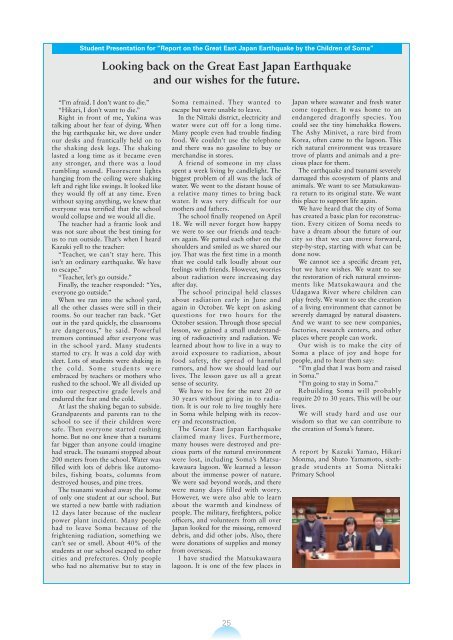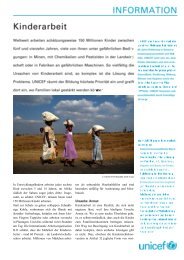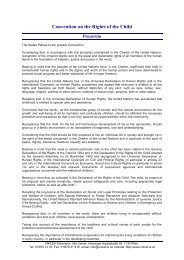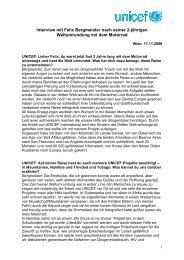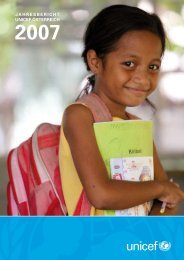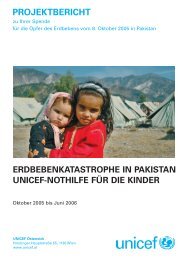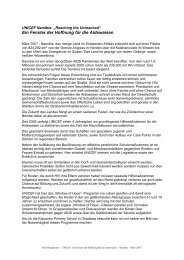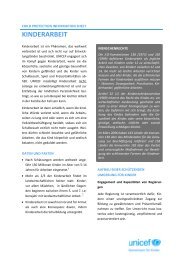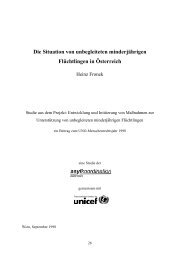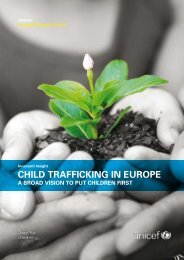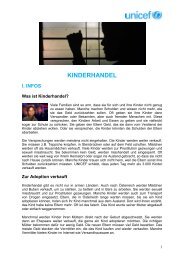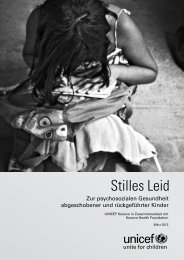Create successful ePaper yourself
Turn your PDF publications into a flip-book with our unique Google optimized e-Paper software.
Student Presentation for “<strong>Report</strong> on the Great East Japan Earthquake by the Children of Soma”<br />
Looking back on the Great East Japan Earthquake<br />
and our wishes for the future.<br />
“I’m afraid. I don’t want to die.”<br />
“Hikari, I don’t want to die.”<br />
Right in front of me, Yukina was<br />
talking about her fear of dying. When<br />
the big earthquake hit, we dove under<br />
our desks and frantically held on to<br />
the shaking desk legs. The shaking<br />
lasted a long time as it became even<br />
any stronger, and there was a loud<br />
rumbling sound. Fluorescent lights<br />
hanging from the ceiling were shaking<br />
left and right like swings. It looked like<br />
they would fly off at any time. Even<br />
without saying anything, we knew that<br />
everyone was terrified that the school<br />
would collapse and we would all die.<br />
The teacher had a frantic look and<br />
was not sure about the best timing for<br />
us to run outside. That’s when I heard<br />
Kazuki yell to the teacher:<br />
“Teacher, we can’t stay here. This<br />
isn’t an ordinary earthquake. We have<br />
to escape.”<br />
“Teacher, let’s go outside.”<br />
Finally, the teacher responded: “Yes,<br />
everyone go outside.”<br />
When we ran into the school yard,<br />
all the other classes were still in their<br />
rooms. So our teacher ran back. “Get<br />
out in the yard quickly, the classrooms<br />
are dangerous,” he said. Powerful<br />
tremors continued after everyone was<br />
in the school yard. Many students<br />
started to cry. It was a cold day with<br />
sleet. Lots of students were shaking in<br />
the cold. Some students were<br />
embraced by teachers or mothers who<br />
rushed to the school. We all divided up<br />
into our respective grade levels and<br />
endured the fear and the cold.<br />
At last the shaking began to subside.<br />
Grandparents and parents ran to the<br />
school to see if their children were<br />
safe. Then everyone started rushing<br />
home. But no one knew that a tsunami<br />
far bigger than anyone could imagine<br />
had struck. The tsunami stopped about<br />
200 meters from the school. Water was<br />
filled with lots of debris like automobiles,<br />
fishing boats, columns from<br />
destroyed houses, and pine trees.<br />
The tsunami washed away the home<br />
of only one student at our school. But<br />
we started a new battle with radiation<br />
12 days later because of the nuclear<br />
power plant incident. Many people<br />
had to leave Soma because of the<br />
frightening radiation, something we<br />
can’t see or smell. About 40% of the<br />
students at our school escaped to other<br />
cities and prefectures. Only people<br />
who had no alternative but to stay in<br />
Soma remained. They wanted to<br />
escape but were unable to leave.<br />
In the Nittaki district, electricity and<br />
water were cut off for a long time.<br />
Many people even had trouble finding<br />
food. We couldn’t use the telephone<br />
and there was no gasoline to buy or<br />
merchandise in stores.<br />
A friend of someone in my class<br />
spent a week living by candlelight. The<br />
biggest problem of all was the lack of<br />
water. We went to the distant house of<br />
a relative many times to bring back<br />
water. It was very difficult for our<br />
mothers and fathers.<br />
The school finally reopened on April<br />
18. We will never forget how happy<br />
we were to see our friends and teachers<br />
again. We patted each other on the<br />
shoulders and smiled as we shared our<br />
joy. That was the first time in a month<br />
that we could talk loudly about our<br />
feelings with friends. However, worries<br />
about radiation were increasing day<br />
after day.<br />
The school principal held classes<br />
about radiation early in June and<br />
again in October. We kept on asking<br />
questions for two hours for the<br />
October session. Through those special<br />
lesson, we gained a small understanding<br />
of radioactivity and radiation. We<br />
learned about how to live in a way to<br />
avoid exposure to radiation, about<br />
food safety, the spread of harmful<br />
rumors, and how we should lead our<br />
lives. The lesson gave us all a great<br />
sense of security.<br />
We have to live for the next 20 or<br />
30 years without giving in to radiation.<br />
It is our role to live toughly here<br />
in Soma while helping with its recovery<br />
and reconstruction.<br />
The Great East Japan Earthquake<br />
claimed many lives. Furthermore,<br />
many houses were destroyed and precious<br />
parts of the natural environment<br />
were lost, including Soma’s Matsukawaura<br />
lagoon. We learned a lesson<br />
about the immense power of nature.<br />
We were sad beyond words, and there<br />
were many days filled with worry.<br />
However, we were also able to learn<br />
about the warmth and kindness of<br />
people. The military, firefighters, police<br />
officers, and volunteers from all over<br />
Japan looked for the missing, removed<br />
debris, and did other jobs. Also, there<br />
were donations of supplies and money<br />
from overseas.<br />
I have studied the Matsukawaura<br />
lagoon. It is one of the few places in<br />
25<br />
Japan where seawater and fresh water<br />
come together. It was home to an<br />
endangered dragonfly species. You<br />
could see the tiny himehakka flowers.<br />
The Ashy Minivet, a rare bird from<br />
Korea, often came to the lagoon. This<br />
rich natural environment was treasure<br />
trove of plants and animals and a precious<br />
place for them.<br />
The earthquake and tsunami severely<br />
damaged this ecosystem of plants and<br />
animals. We want to see Matsukawaura<br />
return to its original state. We want<br />
this place to support life again.<br />
We have heard that the city of Soma<br />
has created a basic plan for reconstruction.<br />
Every citizen of Soma needs to<br />
have a dream about the future of our<br />
city so that we can move forward,<br />
step-by-step, starting with what can be<br />
done now.<br />
We cannot see a specific dream yet,<br />
but we have wishes. We want to see<br />
the restoration of rich natural environments<br />
like Matsukawaura and the<br />
Udagawa River where children can<br />
play freely. We want to see the creation<br />
of a living environment that cannot be<br />
severely damaged by natural disasters.<br />
And we want to see new companies,<br />
factories, research centers, and other<br />
places where people can work.<br />
Our wish is to make the city of<br />
Soma a place of joy and hope for<br />
people, and to hear them say:<br />
“I’m glad that I was born and raised<br />
in Soma.”<br />
“I’m going to stay in Soma.”<br />
Rebuilding Soma will probably<br />
require 20 to 30 years. This will be our<br />
lives.<br />
We will study hard and use our<br />
wisdom so that we can contribute to<br />
the creation of Soma’s future.<br />
A report by Kazuki Yamao, Hikari<br />
Monma, and Shuto Yamamoto, sixthgrade<br />
students at Soma Nittaki<br />
Primary School


